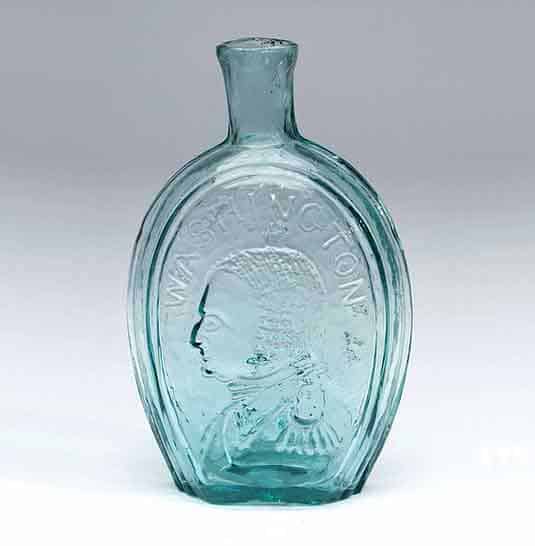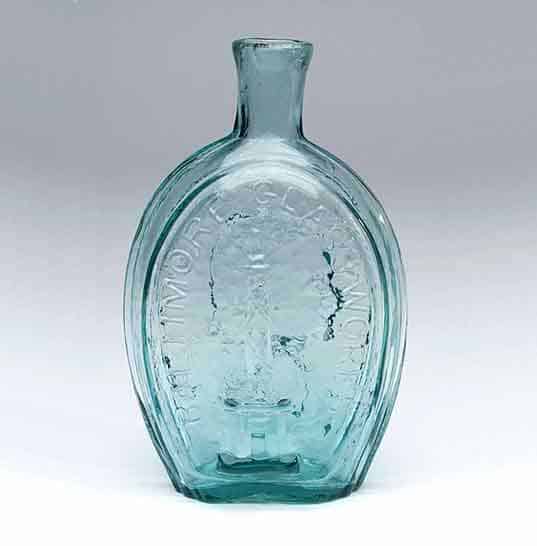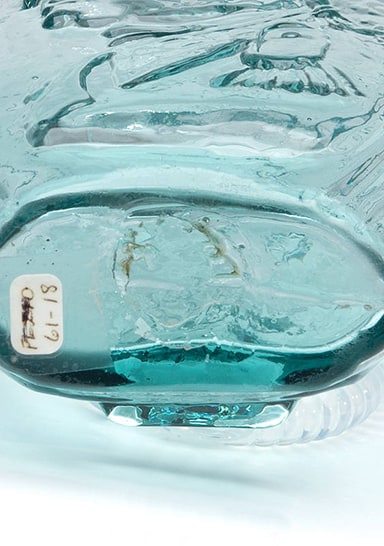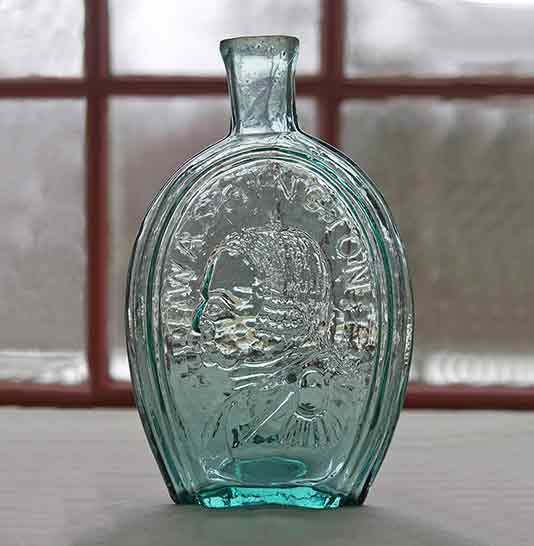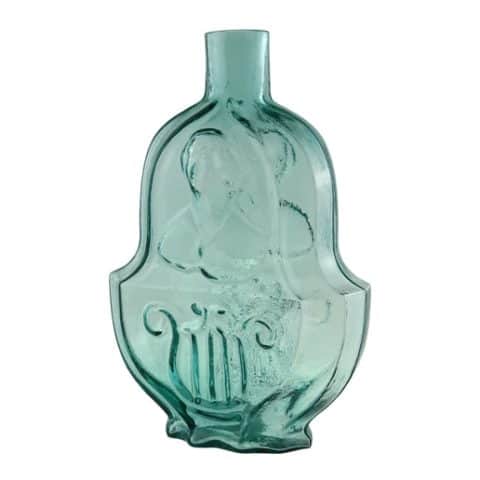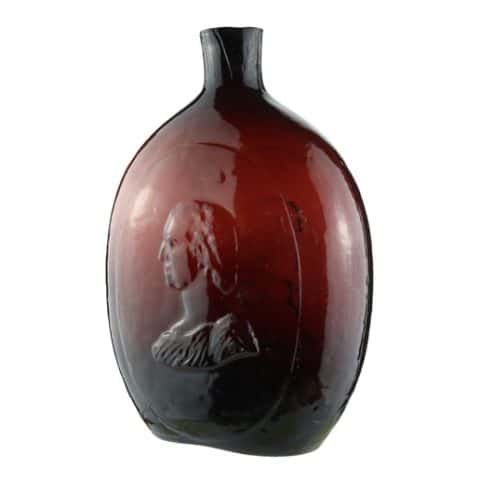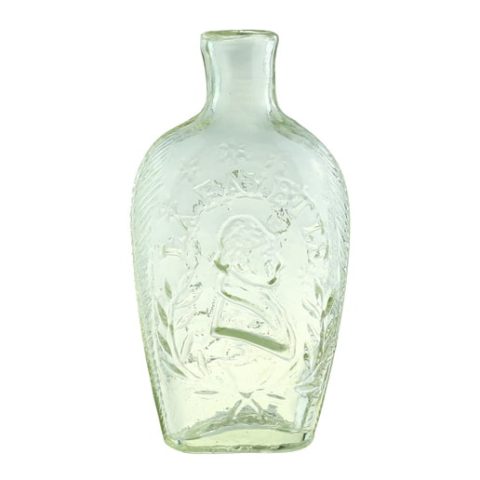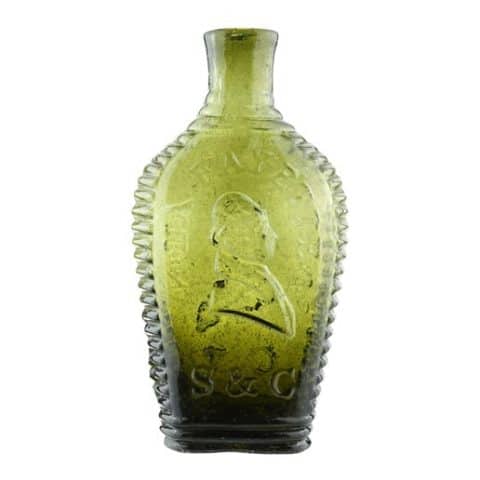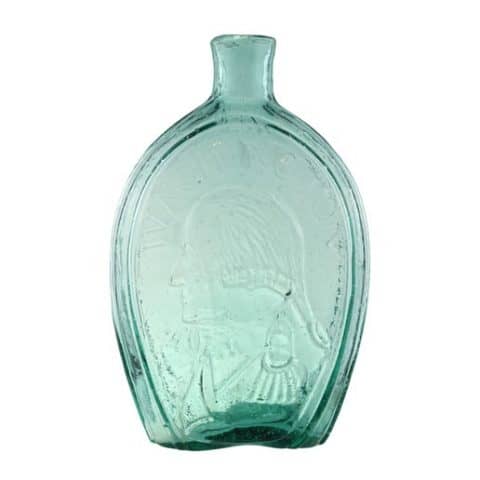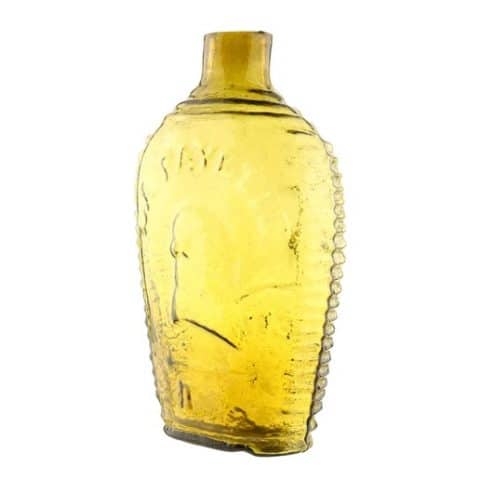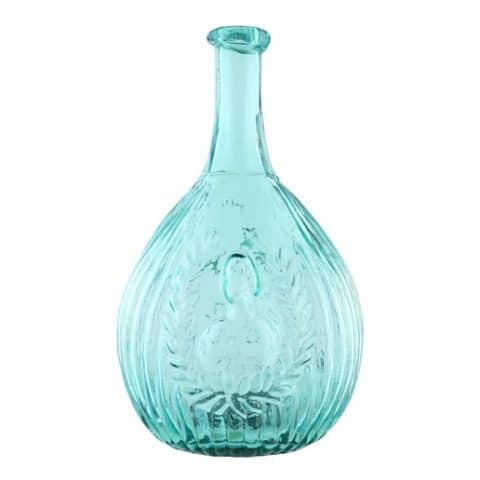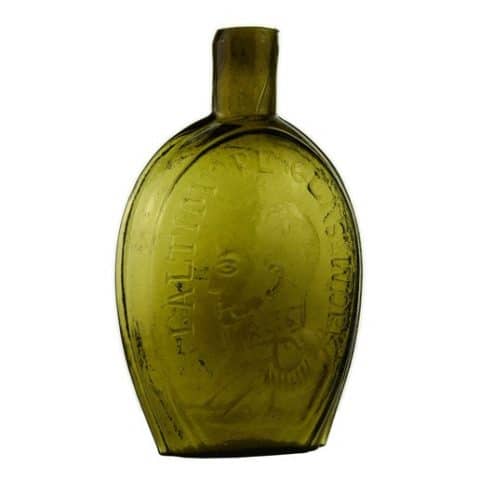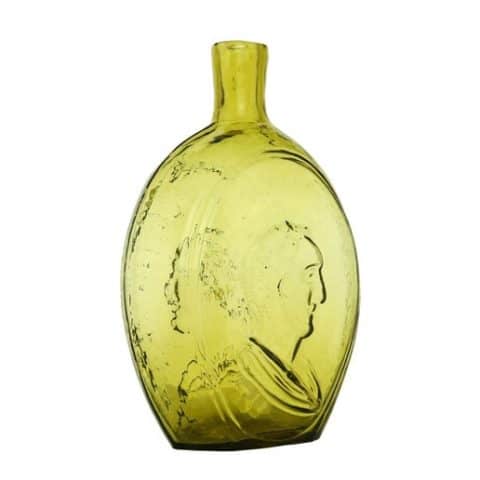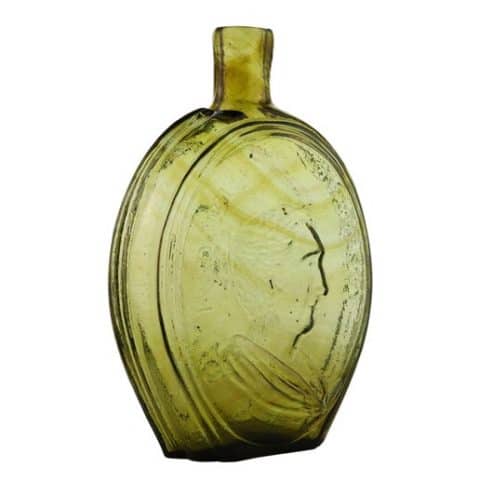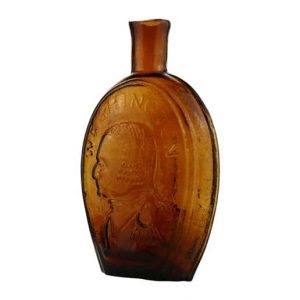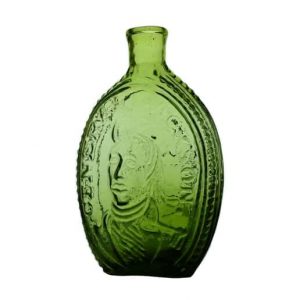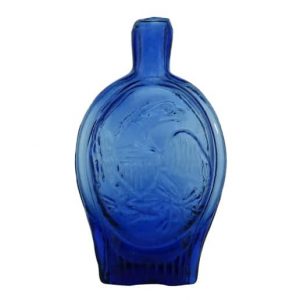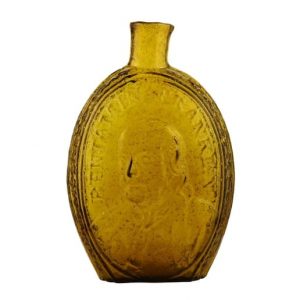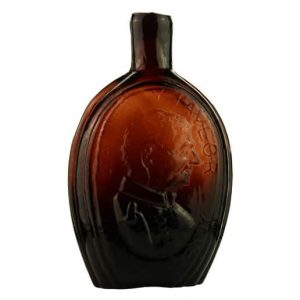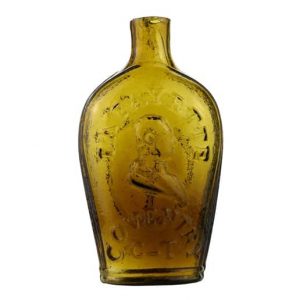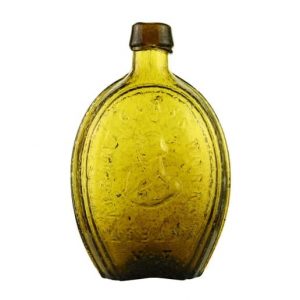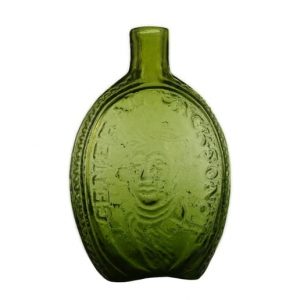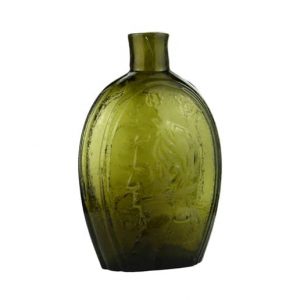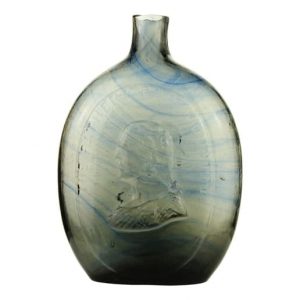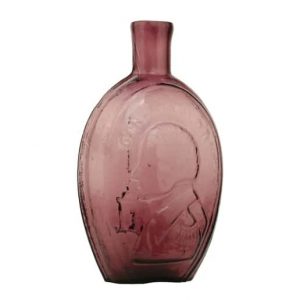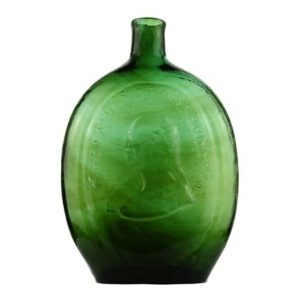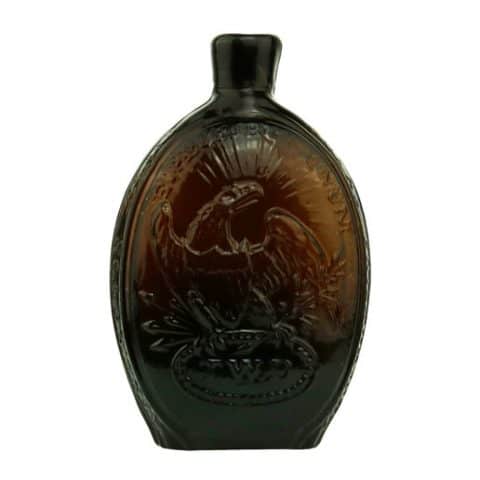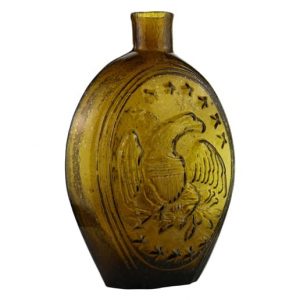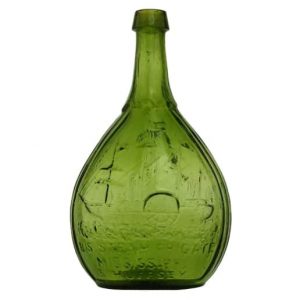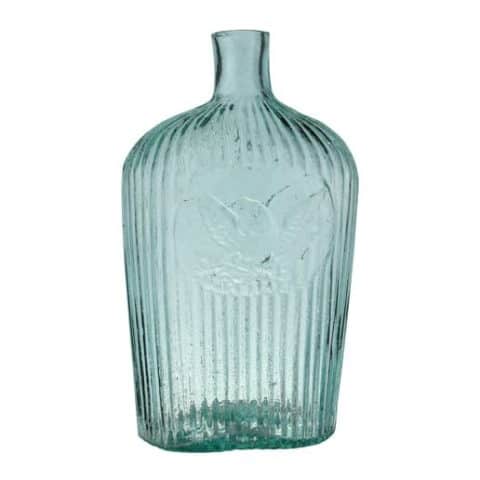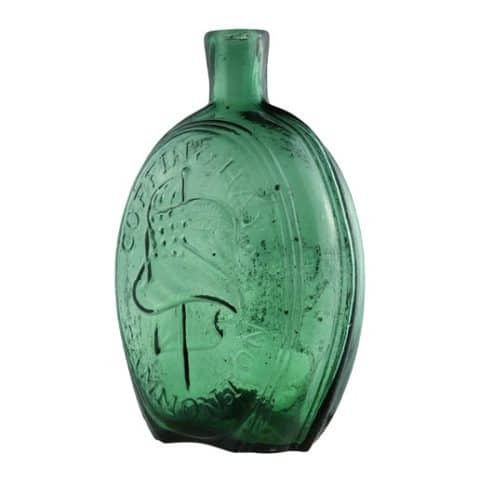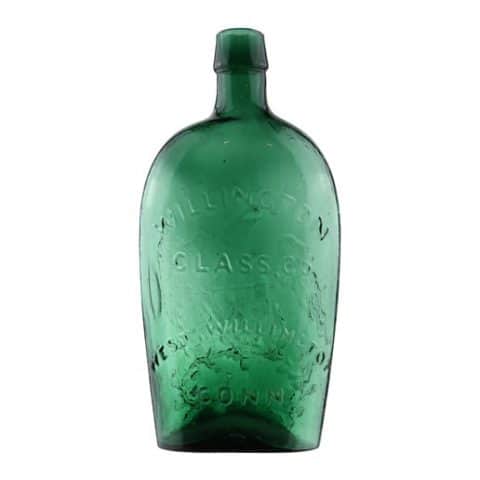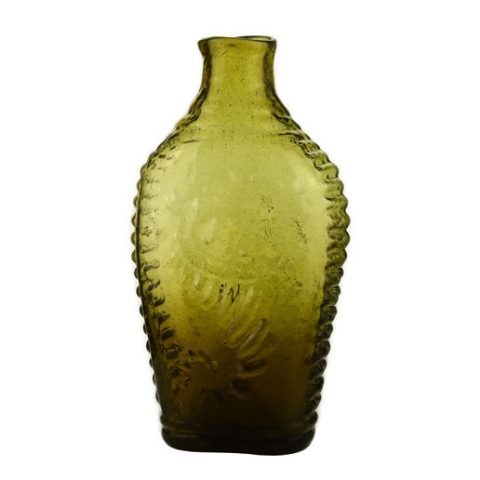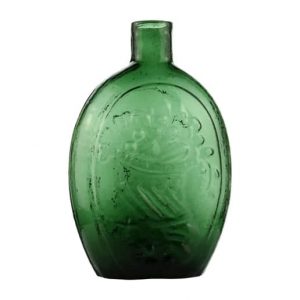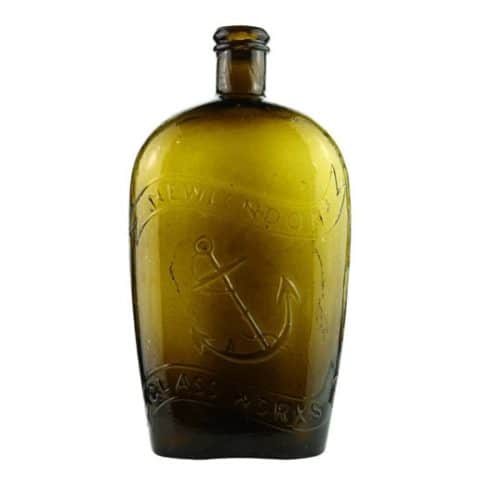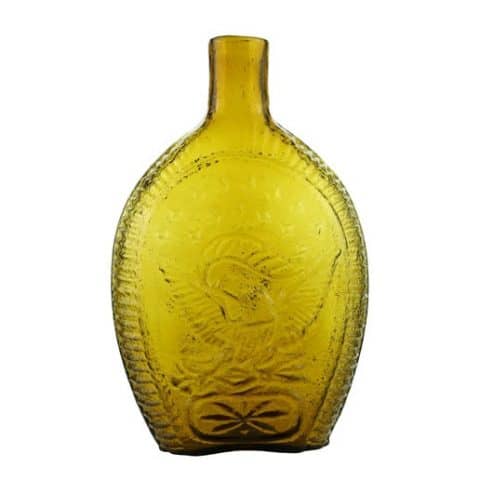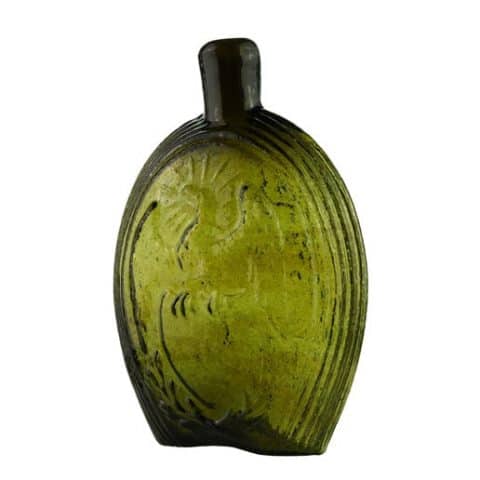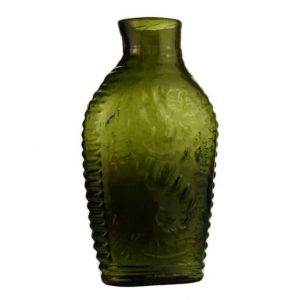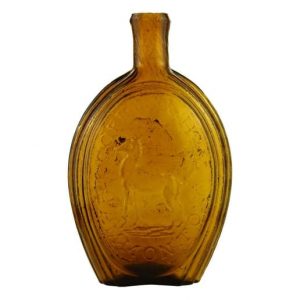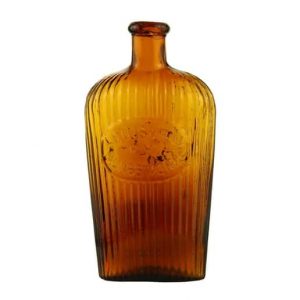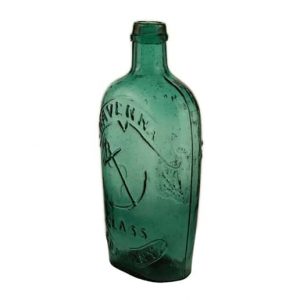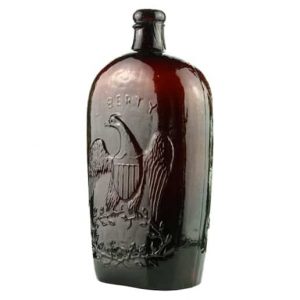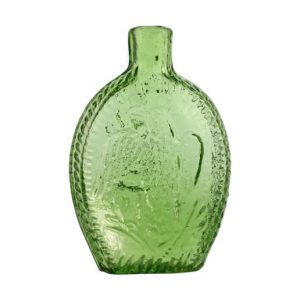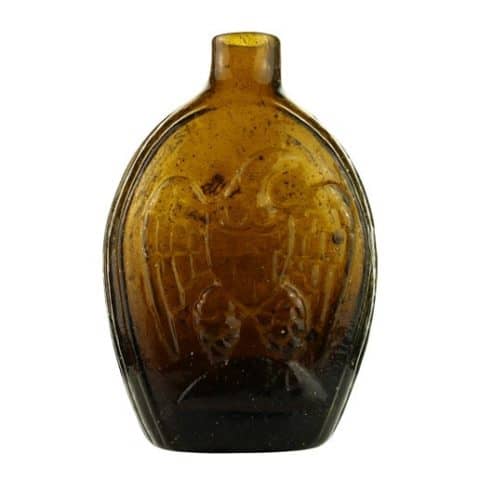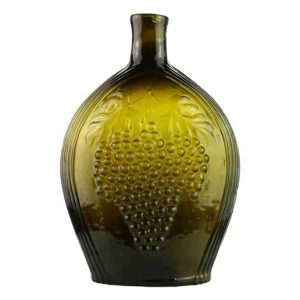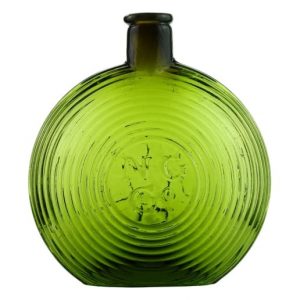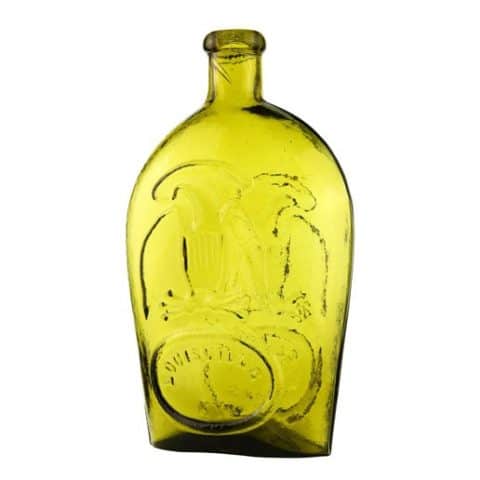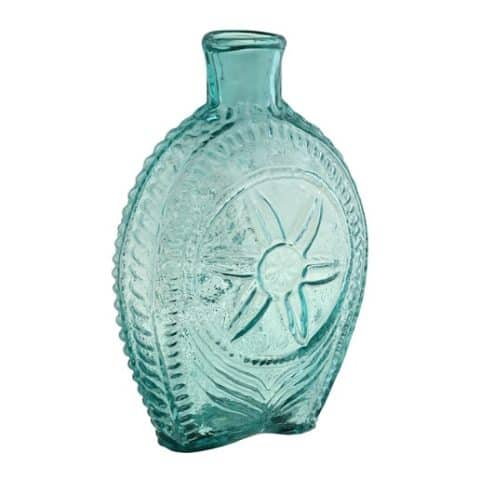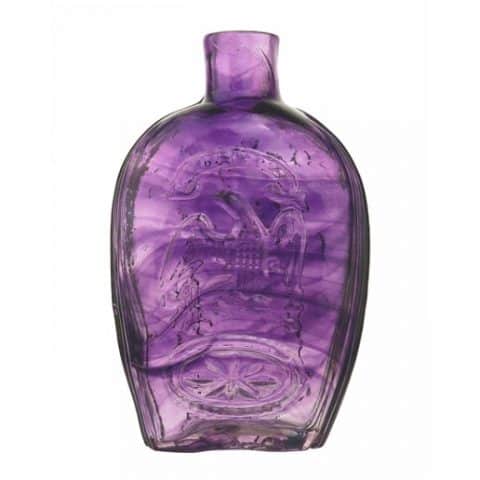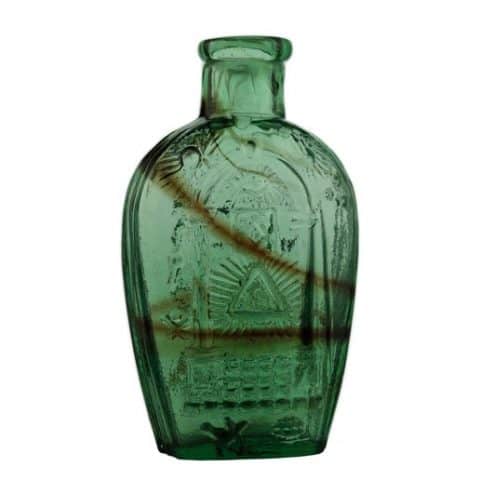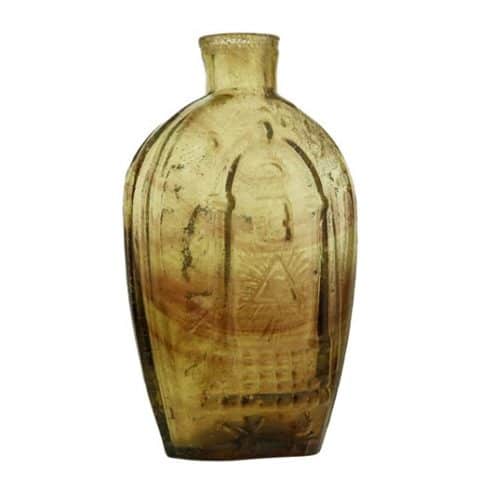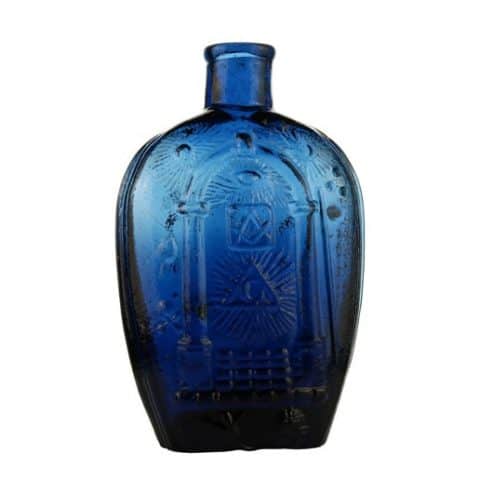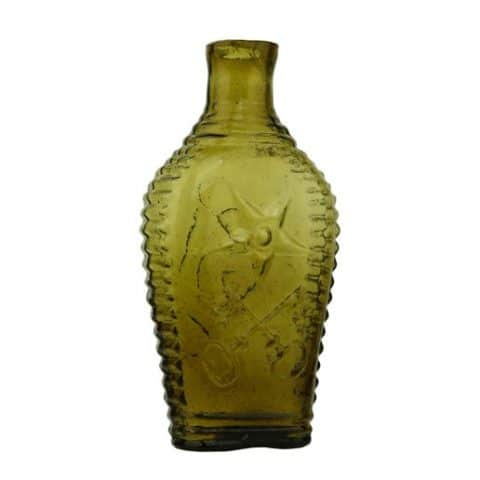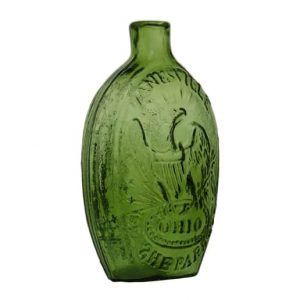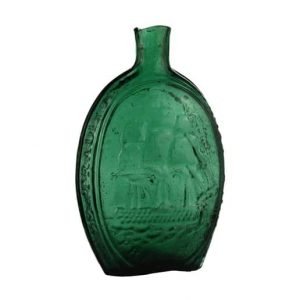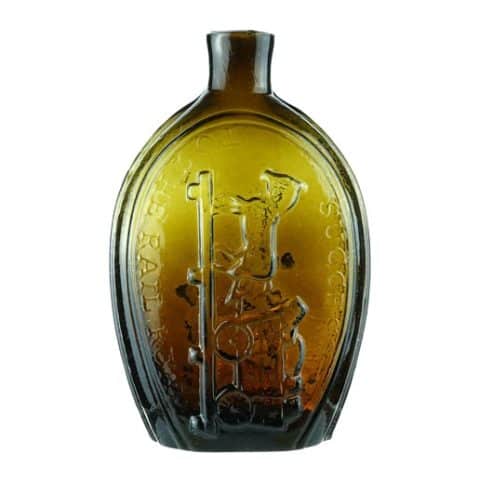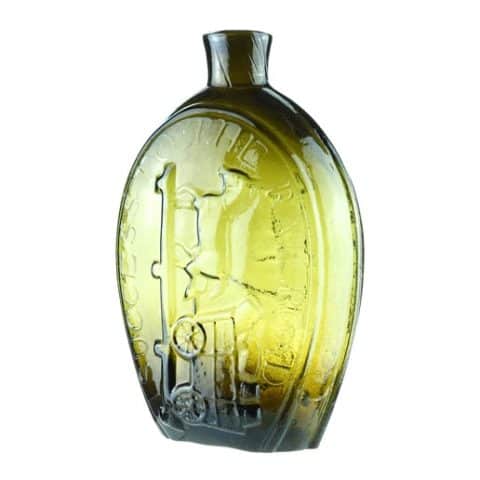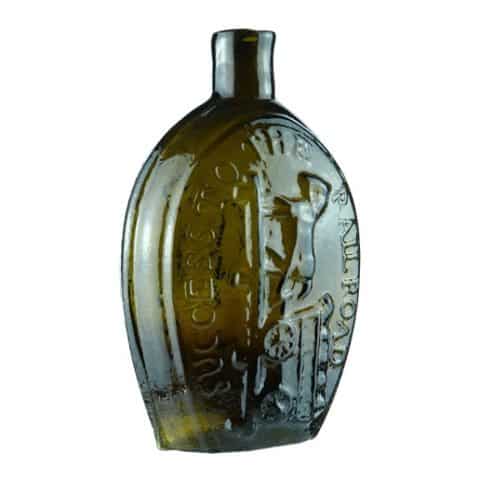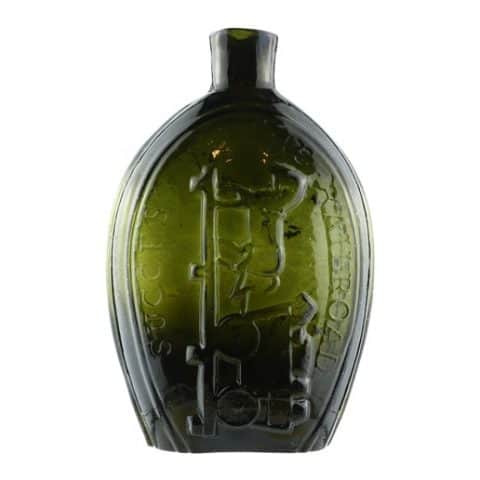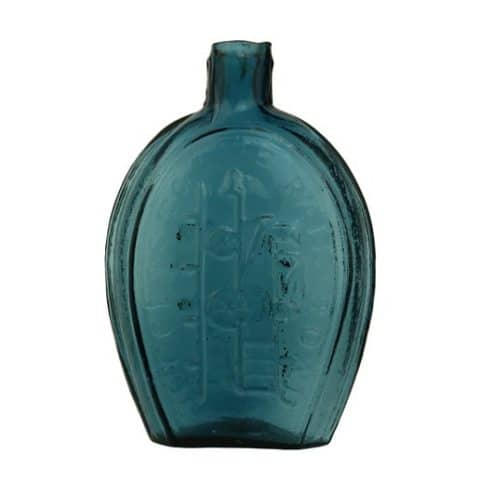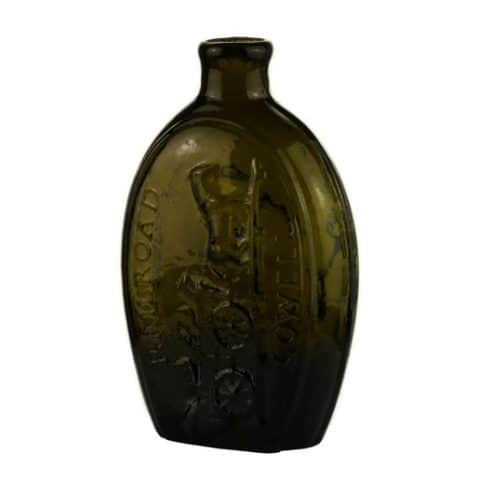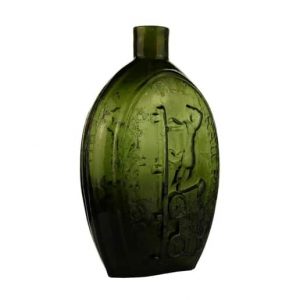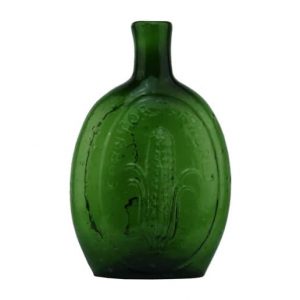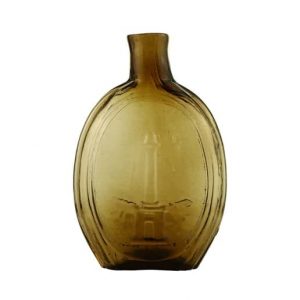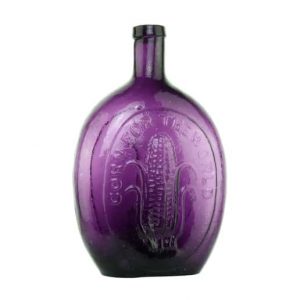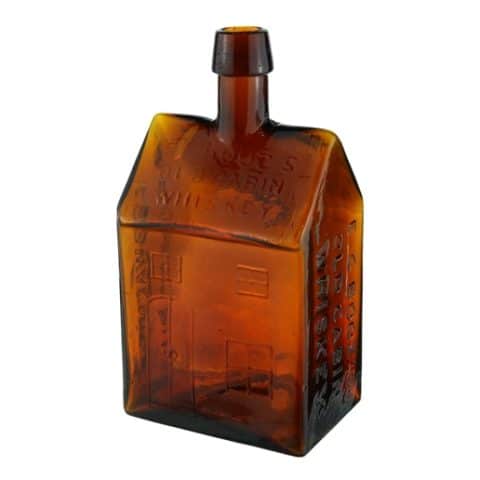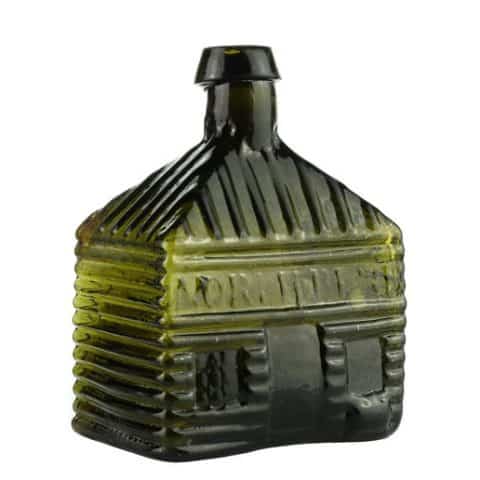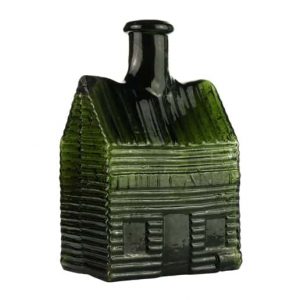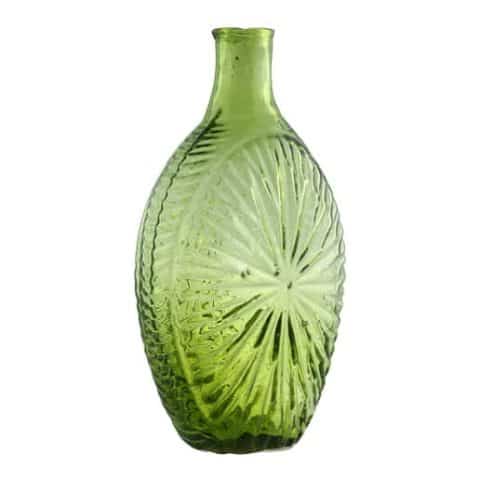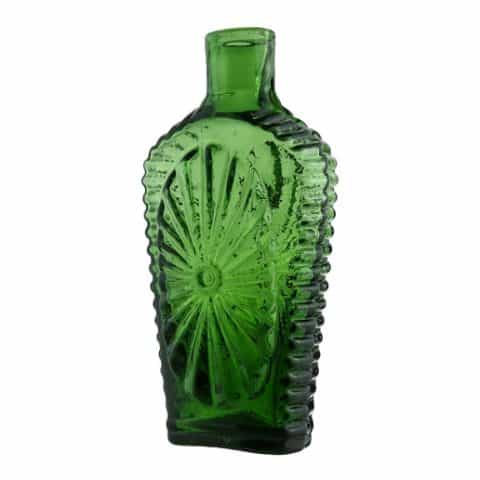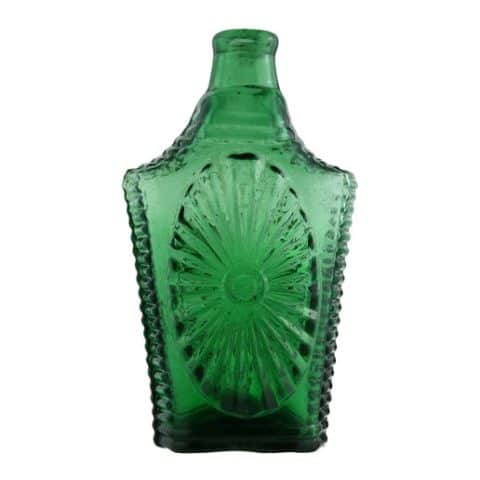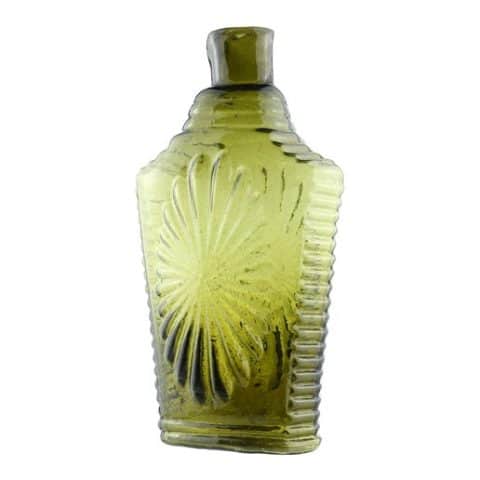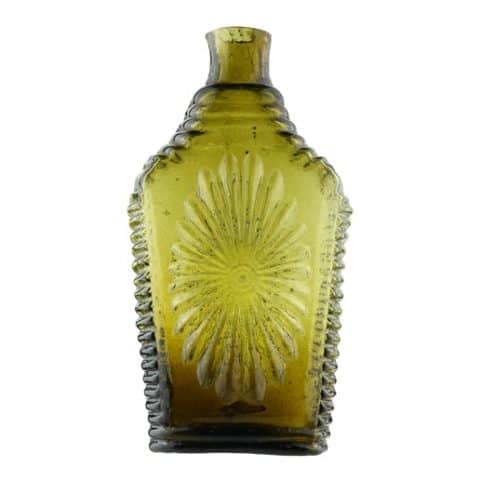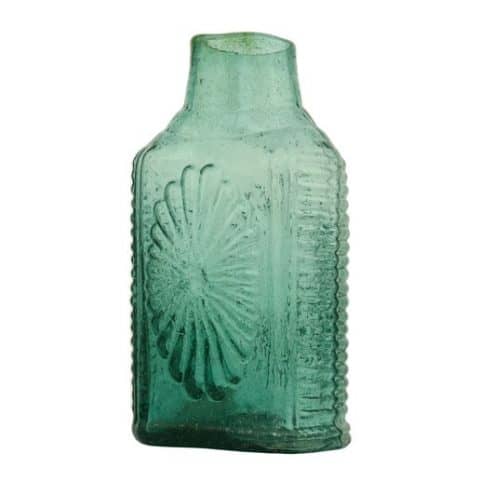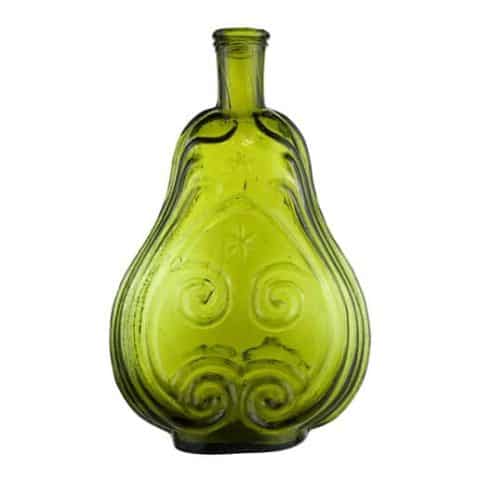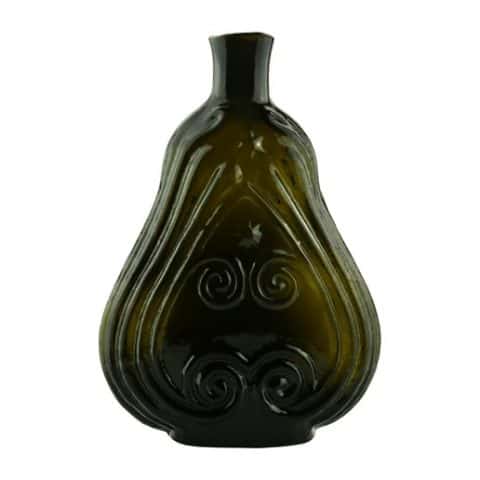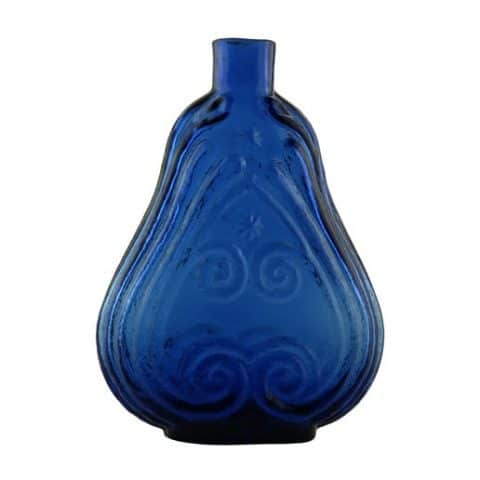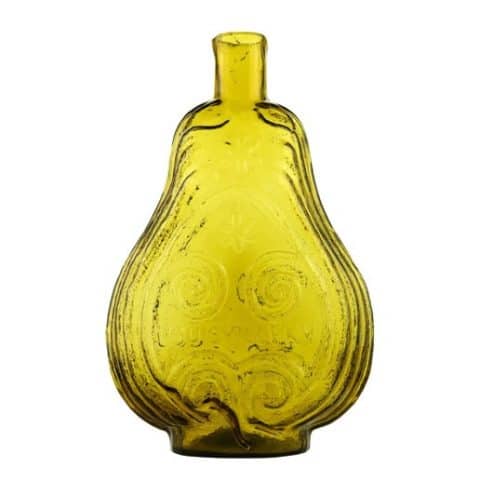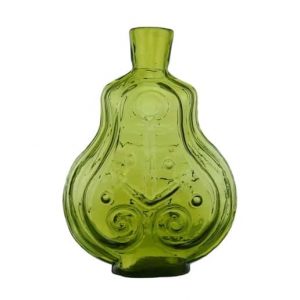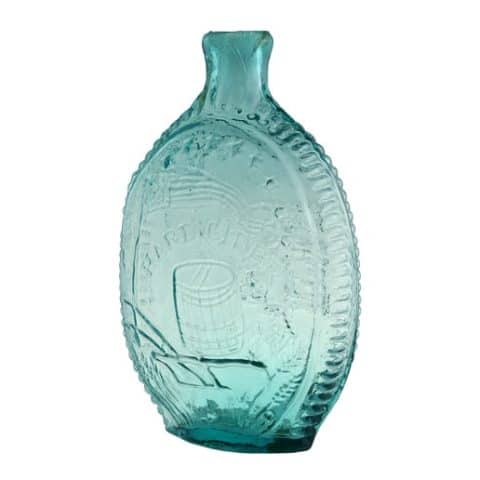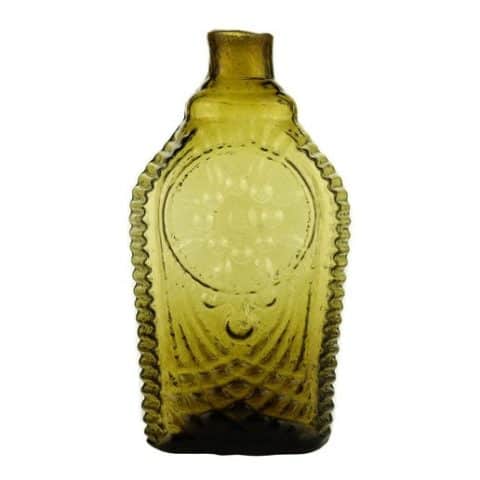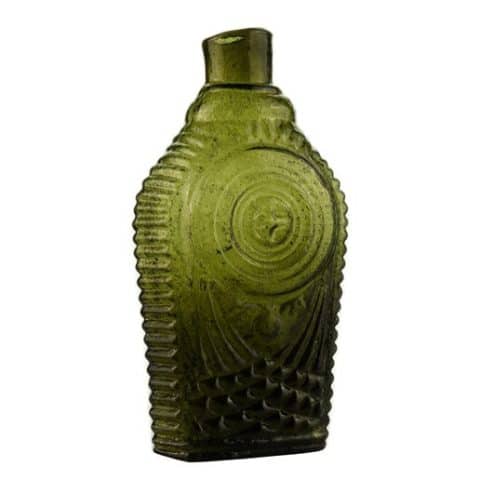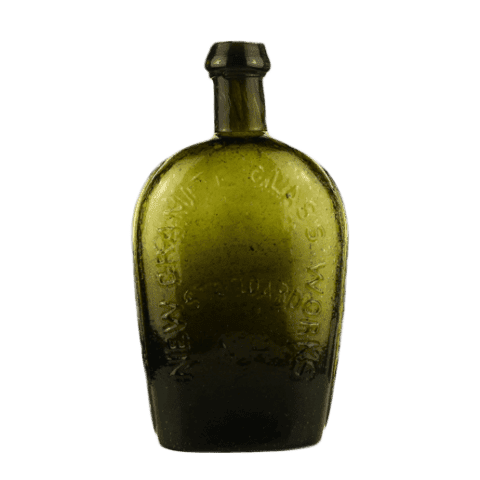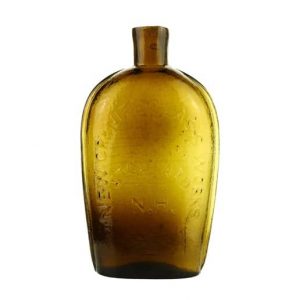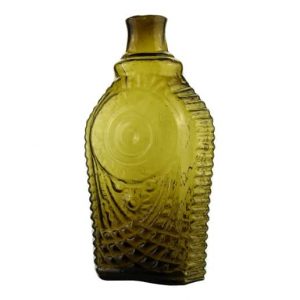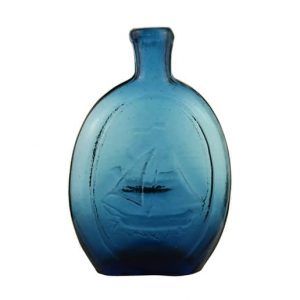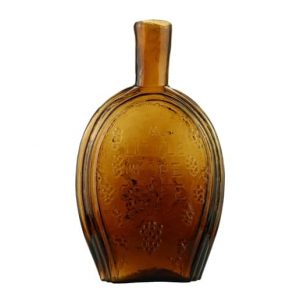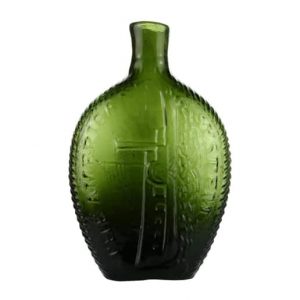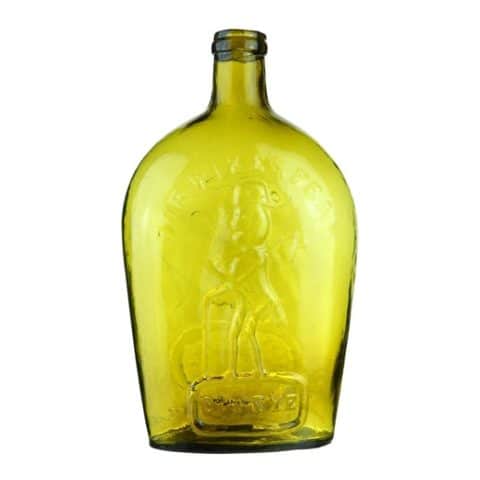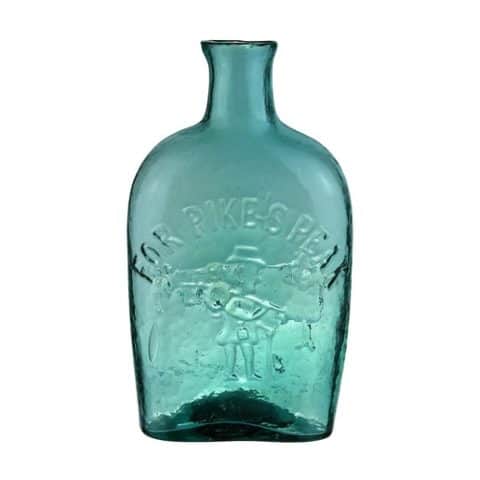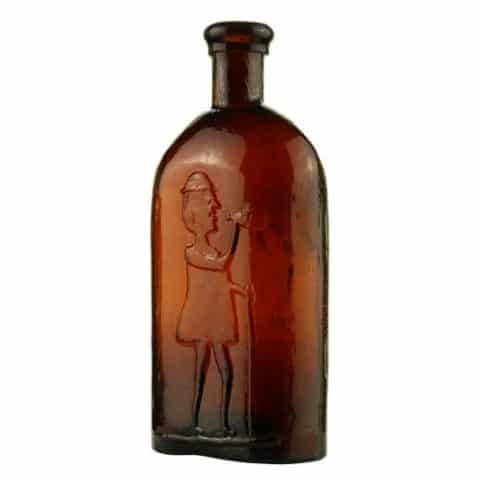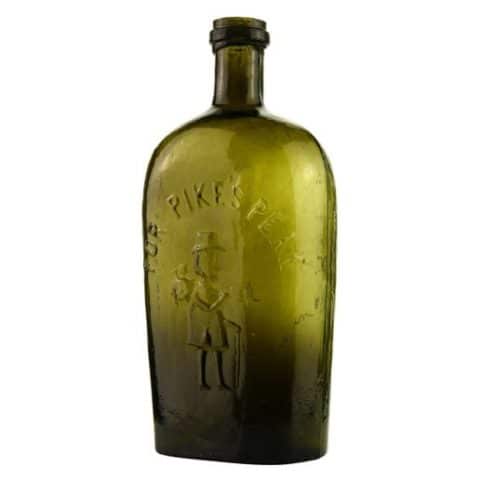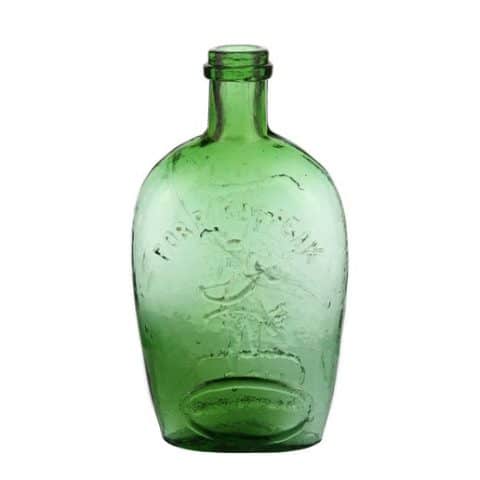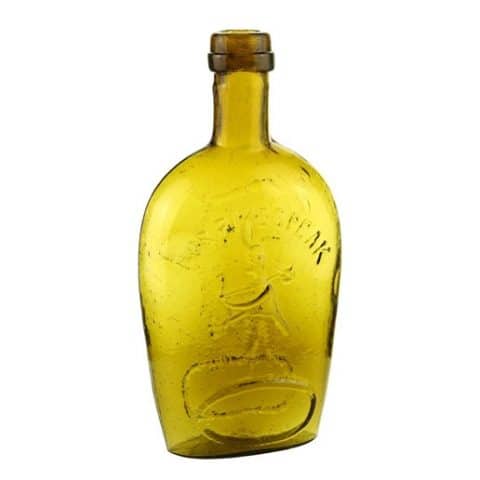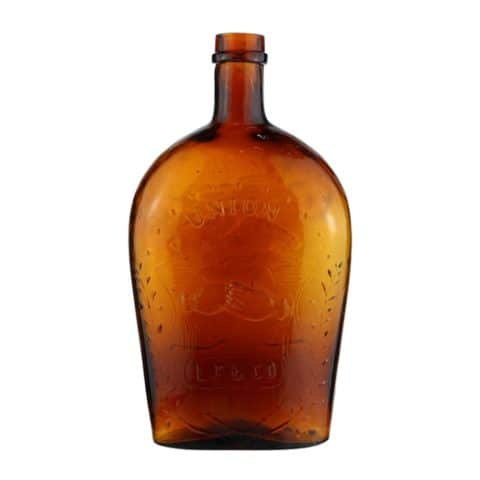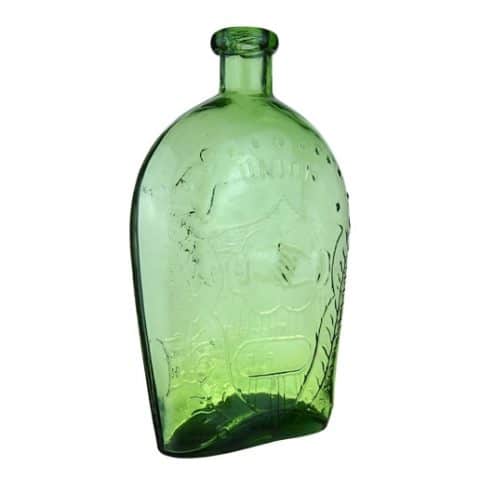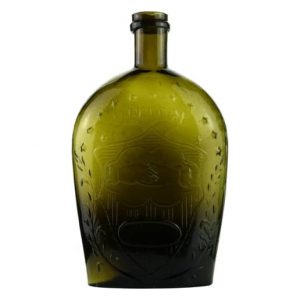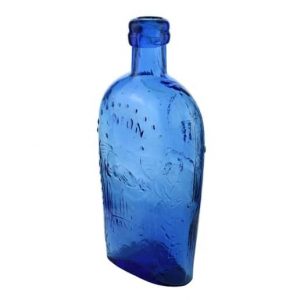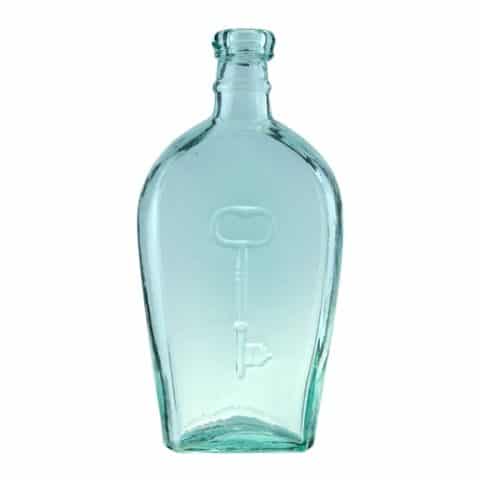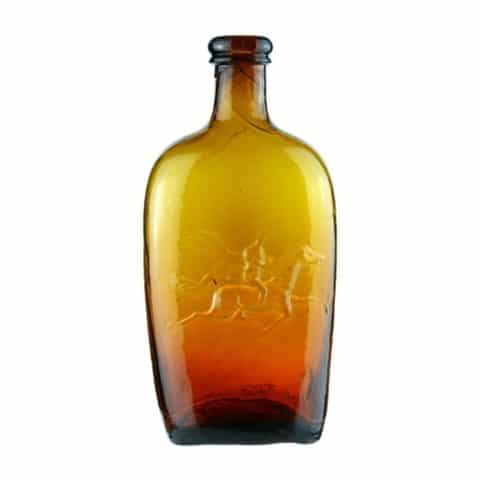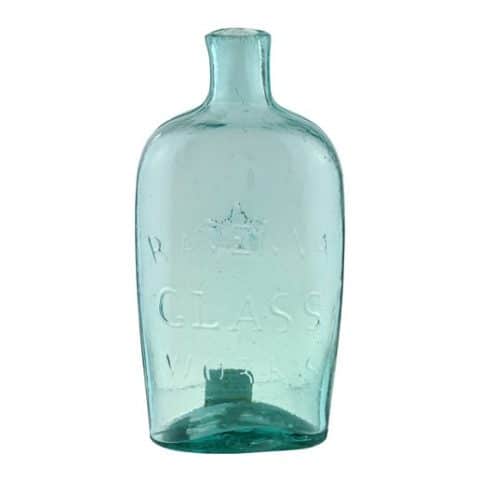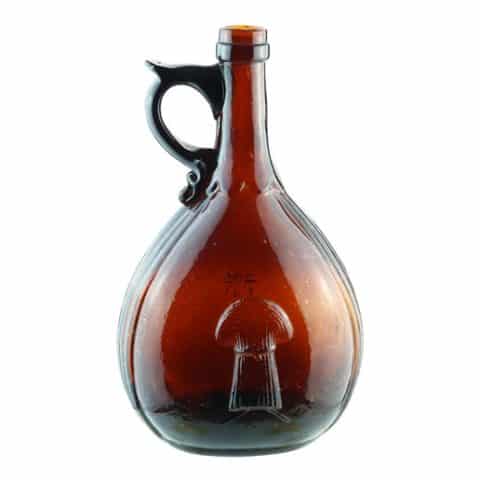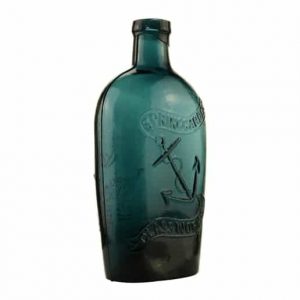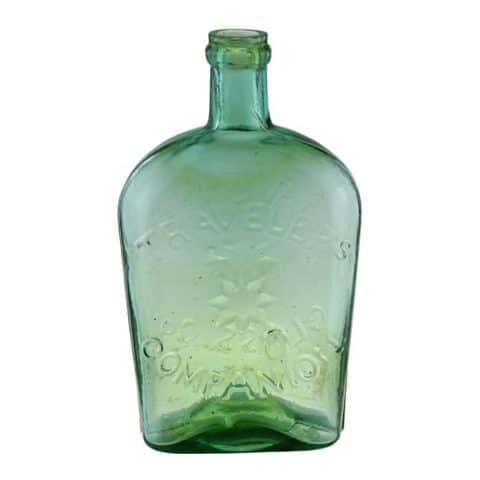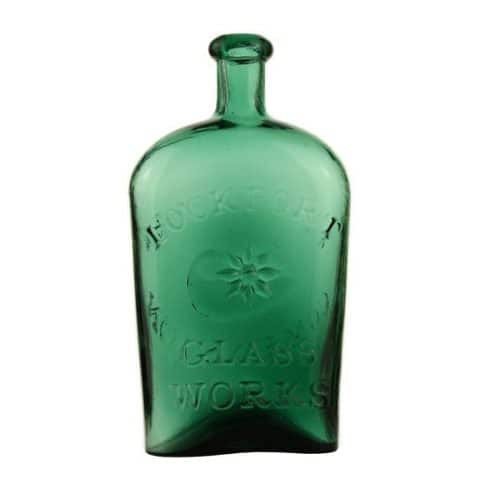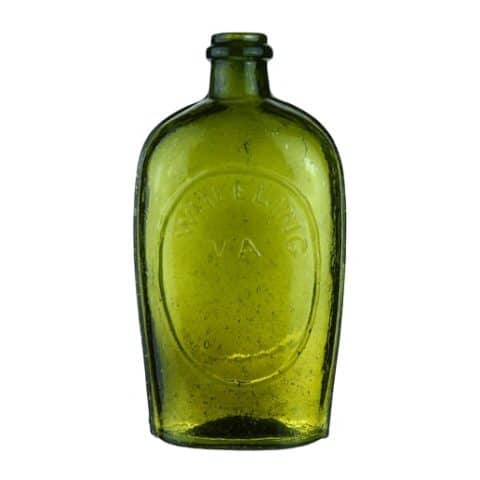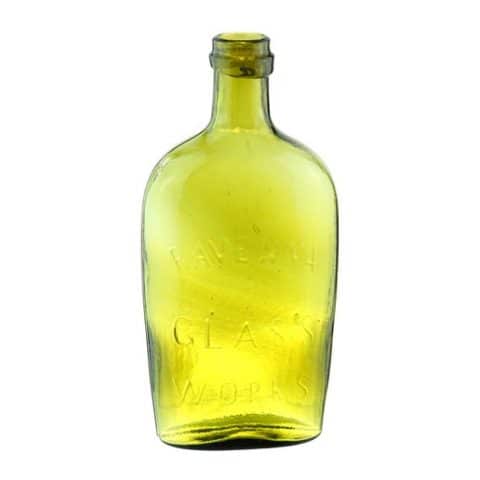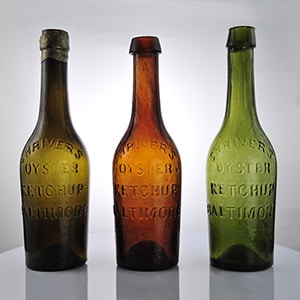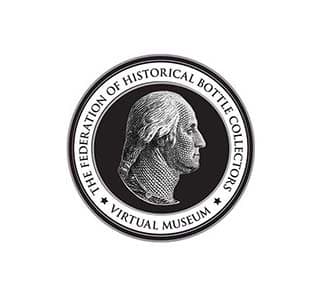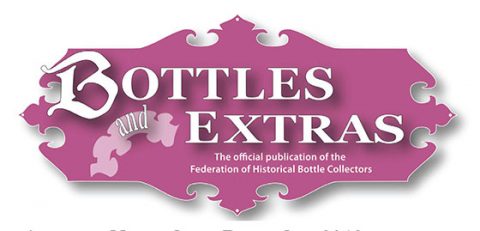GI-18
“Washington” Portrait “Baltimore Glass Works” Monument Flask
GI – 18
“Washington” Portrait – “Baltimore Glass Works” Monument Flask
Baltimore Glass Works, Baltimore, Maryland
Copper Amber Pint
Provenance: Anonymous
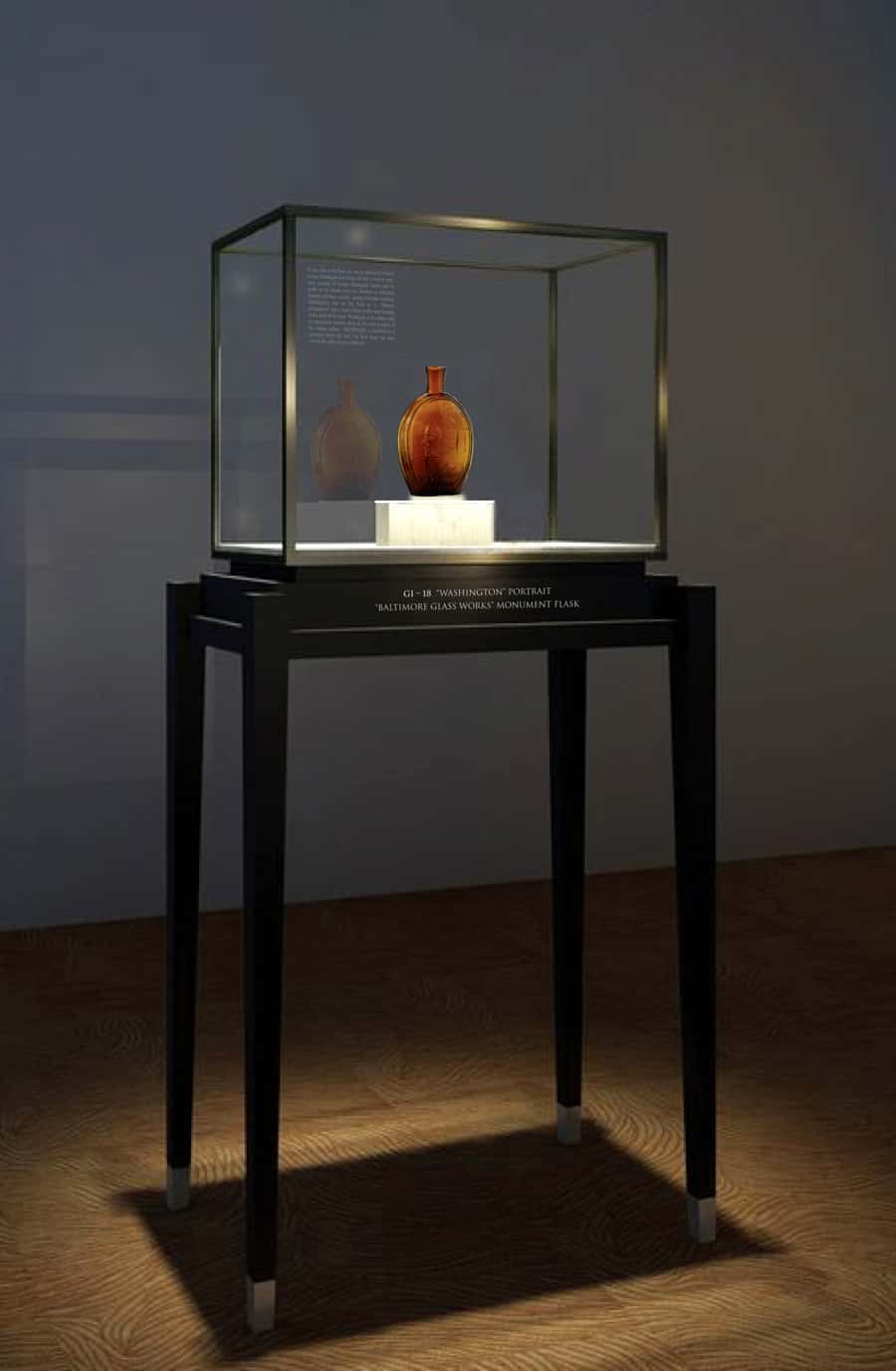
Our museum example of a pint GI-18 Washington Portrait – Baltimore Glass Works Monument flask is exceptional in its copper-amber glass color and condition. The flask pictures George Washington on one side and the Battle Monument in Baltimore, Maryland on the other.
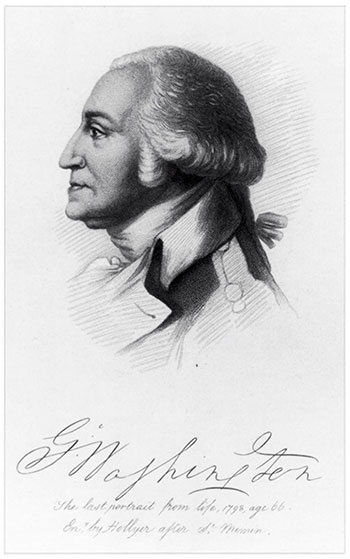
As you look at the flask you see an embossed General George Washington bust facing left with a Roman nose. Most portraits of George Washington render him in profile as his Roman nose was heralded as indicating firmness and inner wisdom. George McKearin describes Washington’s hair on the flask as a “different arrangement” with a braid of hair usually worn hanging at the back of the head. Washington is in uniform with an ornamental shoulder piece on the coat or jacket of the military uniform. ‘WASHINGTON’ is embossed in a semicircle above the bust. The flask edges are three vertical ribs with a heavy medial rib.
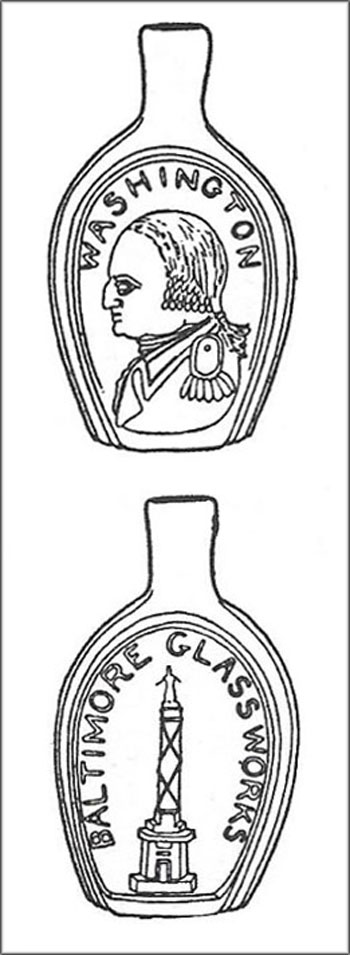
The reverse of the flask has an embossed image of the Battle Monument which was erected to commemorate Baltimore’s defenders who died on September 12 and 13, 1814, in the Battle of North Point and the bombardment of Fort McHenry. In a horseshoe shape around the monument, you will see the embossed copy ‘BALTIMORE GLASS WORKS.’
The pint flask has a plain sheared lip with a base pontil mark. The flask can be found in aqua and light green glass which is considered scarce. Dark emerald green is rare. Dark green, yellow-green, and cornflower examples are very rare; and olive amber, light sapphire, medium sapphire, and medium blue are extremely rare. The flask was blown sometime between 1820 to 1830 at Baltimore Glass Works on Federal Hill on the inner harbor in downtown Baltimore City.
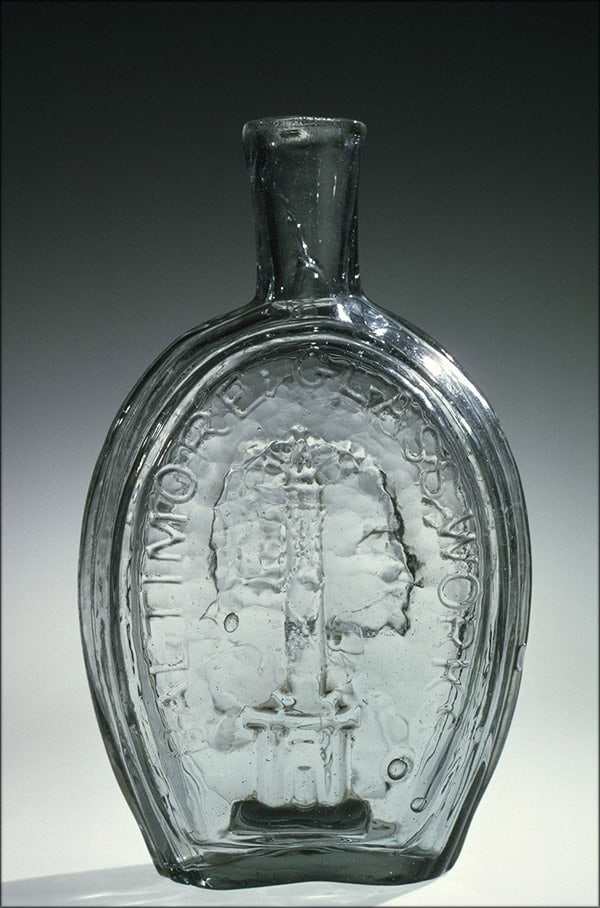
The 39 foot tall Battle Monument is located in Battle Monument Square on North Calvert Street between East Fayette and East Lexington Streets and was designed by Baltimore architect J. Maximilian M. Godefroy and built between 1815 and 1825.
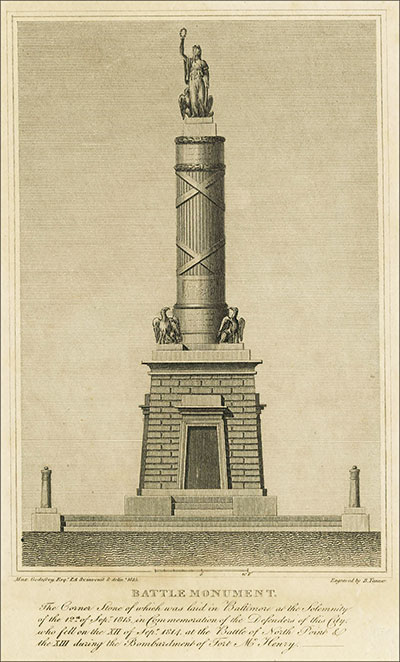
The base of the monument is an Egyptian Revival cenotaph. It is an unusually democratic monument for the time in that it records the names of all who died, regardless of rank. The eighteen layers of the marble base represent the eighteen states that made up the United States at the time of the War of 1812. A griffin is at each corner of the base. The column, carved as a Roman fasces, is bound with cords listing the names of soldiers who died during the battle, while the names of officers who died are at the top. The monument is topped by an 8 feet tall 2,750 pound Carrara marble statue by Antonio Capellano of a female figure representing the City of Baltimore that wears a crown of victory and holds a laurel wreath in one hand and a ship’s rudder in the other. It was hoisted to the top of the column during the middle of the period of construction on the eighth-anniversary ceremonies, Defenders Day, September 12, 1822.
Colloquially called Lady Baltimore, the statue was relocated to the Maryland Historical Society on October 5, 2013, in order to preserve it from further damage caused by time and nature. It was replaced by a concrete replica. The monument is the oldest stone monument and the first public war memorial in the United States. The monument is depicted on the seal of the City of Baltimore that was adopted in 1827 and the city’s flag adopted in the early 20th century.
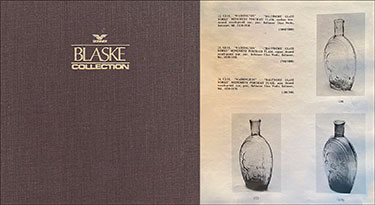
When the Edmund & Jayne Blaske Collection of American Historical Flasks was auctioned in 1983, there were three lots of GI-18 Washington Baltimore Glass Works Monument Portrait flasks noted. Lot 22 was medium blue, Lot 23 was copper and Lot 24 was aqua. All three had sheared mouths and pontil scars.
Primary Image: The GI-18 Washington Portrait – Baltimore Glass Works Monument flask imaged on location by the FOHBC Virtual Museum midwest studio led by Alan DeMaison.
Support Images: Auction Lot 129: “Washington” And Bust – “Baltimore Glass Works” And Monument Portrait Flask, Baltimore Glass Works, Baltimore, Maryland, 1820-1840. Aquamarine, sheared mouth – pontil scar, pint. GI-18 Heavily whittled exterior surface. Bold embossing. Fine condition. – Norman C. Heckler & Company
Support Image: G1-18 Flask – Greenish tint glass; blown-molded; plain lip, pontil mark. Obverse: Washington, profile facing left, Roman nose. Different arrangement of hair, long queue; uniform with epaulet. Reverse: Battle Monument, Baltimore. Inscription: “WASHINGTON.” in semi-circle above bust. Reverse: “BALTIMORE GLASS WORKS.” in semi-circle around monument. Edges: three vertical ribs with heavy medial rib. McKearin Antiques, Source Odenweilder, A., Former Collection – Corning Museum of Glass
Support Image: Battle Monument. Engraving of Battle Monument, ca. 1815, by Benjamin Tanner. Designed by architect Maximilian Godefroy. Commemorates the Defenders of Baltimore who fell on the 12th of September, 1814 at the Battle of North Point and the 13th during the Bombardment of Fort McHenry. Published by S. C. Atkinson, for “The Casket or Flowers of Literature, Wit, and Sentiment.” Philadelphia, September 1828, No. 9. New Series. – Maryland Historical Society
Support: Reference to American Bottles and Flasks and Their Ancestry by Helen McKearin and Kenneth M. Wilson, Crown Publishers Inc., New York, 1978.
Join the FOHBC: The Virtual Museum is a project of the Federation of Historical Bottle Collectors (FOHBC). To become a member.

